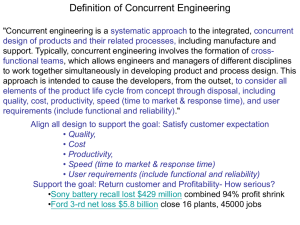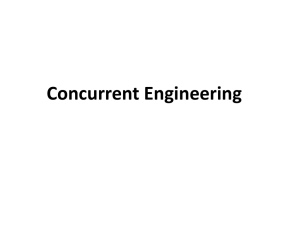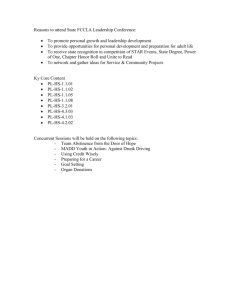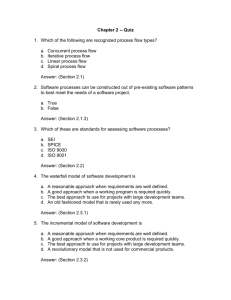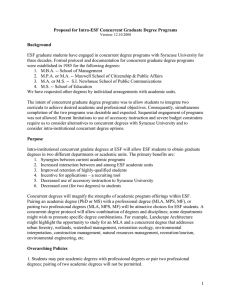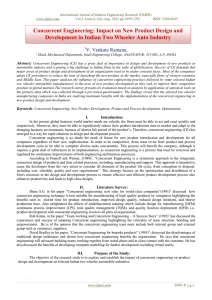Concurrent Engineering Brief Synopsis:
advertisement
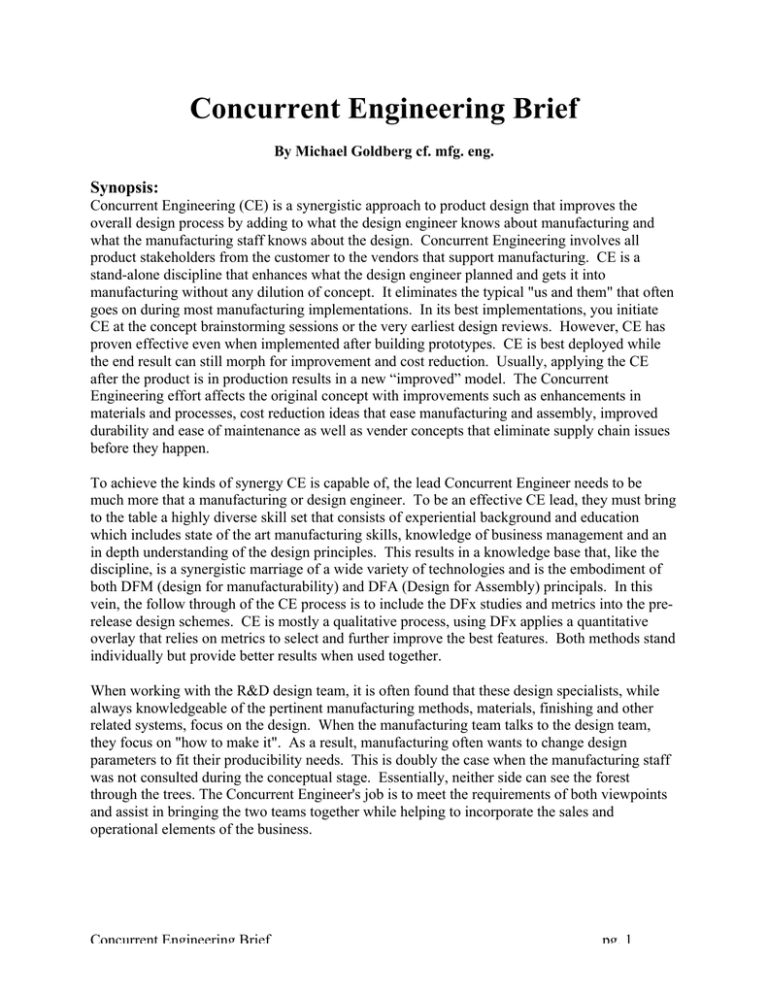
Concurrent Engineering Brief By Michael Goldberg cf. mfg. eng. Synopsis: Concurrent Engineering (CE) is a synergistic approach to product design that improves the overall design process by adding to what the design engineer knows about manufacturing and what the manufacturing staff knows about the design. Concurrent Engineering involves all product stakeholders from the customer to the vendors that support manufacturing. CE is a stand-alone discipline that enhances what the design engineer planned and gets it into manufacturing without any dilution of concept. It eliminates the typical "us and them" that often goes on during most manufacturing implementations. In its best implementations, you initiate CE at the concept brainstorming sessions or the very earliest design reviews. However, CE has proven effective even when implemented after building prototypes. CE is best deployed while the end result can still morph for improvement and cost reduction. Usually, applying the CE after the product is in production results in a new “improved” model. The Concurrent Engineering effort affects the original concept with improvements such as enhancements in materials and processes, cost reduction ideas that ease manufacturing and assembly, improved durability and ease of maintenance as well as vender concepts that eliminate supply chain issues before they happen. To achieve the kinds of synergy CE is capable of, the lead Concurrent Engineer needs to be much more that a manufacturing or design engineer. To be an effective CE lead, they must bring to the table a highly diverse skill set that consists of experiential background and education which includes state of the art manufacturing skills, knowledge of business management and an in depth understanding of the design principles. This results in a knowledge base that, like the discipline, is a synergistic marriage of a wide variety of technologies and is the embodiment of both DFM (design for manufacturability) and DFA (Design for Assembly) principals. In this vein, the follow through of the CE process is to include the DFx studies and metrics into the prerelease design schemes. CE is mostly a qualitative process, using DFx applies a quantitative overlay that relies on metrics to select and further improve the best features. Both methods stand individually but provide better results when used together. When working with the R&D design team, it is often found that these design specialists, while always knowledgeable of the pertinent manufacturing methods, materials, finishing and other related systems, focus on the design. When the manufacturing team talks to the design team, they focus on "how to make it". As a result, manufacturing often wants to change design parameters to fit their producibility needs. This is doubly the case when the manufacturing staff was not consulted during the conceptual stage. Essentially, neither side can see the forest through the trees. The Concurrent Engineer's job is to meet the requirements of both viewpoints and assist in bringing the two teams together while helping to incorporate the sales and operational elements of the business. Concurrent Engineering Brief pg. 1 Customer Satisfaction: Since MTMCo often enters the process after the client recognizes the problem and the fact that the in-house staff cannot solve it because they already have vested interests and positions. We start work reviewing and evaluating the product, its performance and costs, the clients manufacturing systems and their supply chain. We discuss the client’s plant and possible outsourcing options and make sure both are up to meeting product design performance as well as cost and manufacturing implementation criteria on a consistent basis. MTMCo has excelled in customer satisfaction because staff embodies Concurrent Engineering principals. Manufacturing requirements are integral with the design process. We are experts at implementing the Concurrent Engineering process either to existing products or to new design projects. After we discuss your requirements, please ask for references that had similar needs to yours. Completed Projects: MTMCo has completed three Concurrent Engineering projects. The, first, was designing a specialized computerized point of sale type currency exchange system that was conceived to replace the current food stamp and other paper based welfare systems with an optically based electronic card. We also supplied the conceptual manufacturing plan and assisted with setting up vendors, plant design and general manufacturing implementation. This client was a start up company that did not make it. Second, we are designed an NFS compliant plastic refrigeration pallet for the meat packing industry. This product design was sold to Swift Meat packaging and is in use and production today. Third, we assisted with an integration project to create a paperless manufacturing environment for a major canning machine manufacturer. Over the years, MTMCo has worked on several projects designing and implementing into production other computer based devices. This includes a conventional point of sale system, a control module for a digital tape recorder, a solid-state electric motor tester and a regenerative desiccant based gas/air dryer. On the purely manufacturing side, MTMCo spent two years primarily consulting for Alcoa Packaging Machinery. There, we worked with both the Manufacturing and R&D groups to teach and implement concurrent engineering processes for several new can-making machinery systems and to help implement Group Technology Family of parts methods for cellular manufacturing. For various other clients, projects have included improving manufacturing processes and/or design for various mechanical devices such as components for the computer and video production industries, an orthopedic instrument to improve implant procedures, orthodontic devices and NSF certified food processing equipment. Concurrent Engineering Brief pg. 2 A Visual Example of Concurrent Engineering in action: Before and After of Digital Video Tape Recorder Control Exemplify CE team results this by contrasting the original front panel (upper) with the revised design front panel (lower). Using software control of switch function and improved ergonomic design eliminated 42 switches and 12 leds. A standard onequarter-VGA gray scale display replaced custom unit improving readability. The original design used a complex hinge with 12 parts per side. The revised design replaced this with a integral tongue and grove design that eliminated all the hinge parts and retained articulating access to the panel's back side. The original design required 3 printed circuit boards, 2 hours of assembly and approximately $50,000 of tooling. The new design used 2 printed circuit boards, 1/2 an hour of assembly and approximately $4,500 of tooling. The result was to reduce product cost from $9,800 to $2,400 while significantly enhancing the feature set and improving product reliability. In this product MTM supplied the revise panel and package design. Manufacturing Technology & Methods Company 17 Conifer Rd, Golden, CO 80401 phone:303-589-5343 . . . fax:740-539-5343 Concurrent Engineering Brief pg. 3
